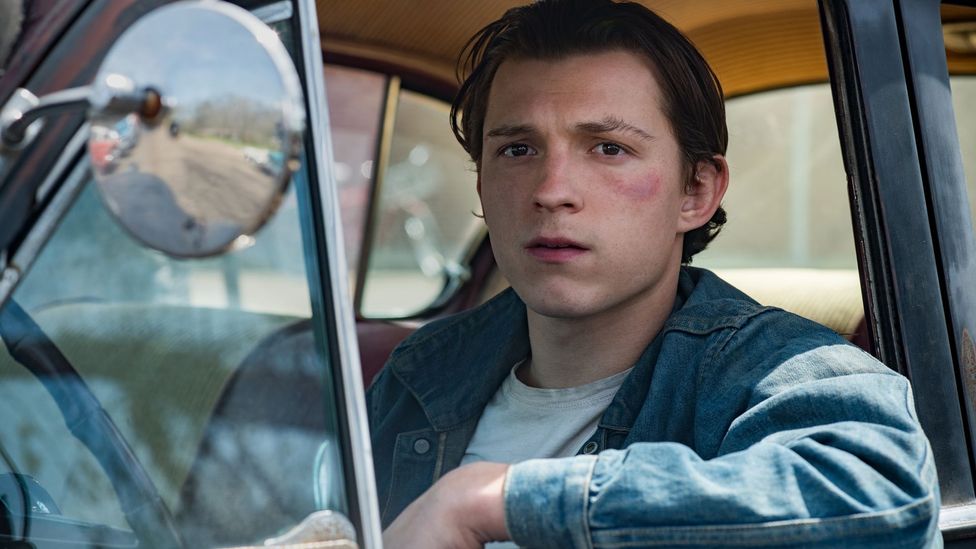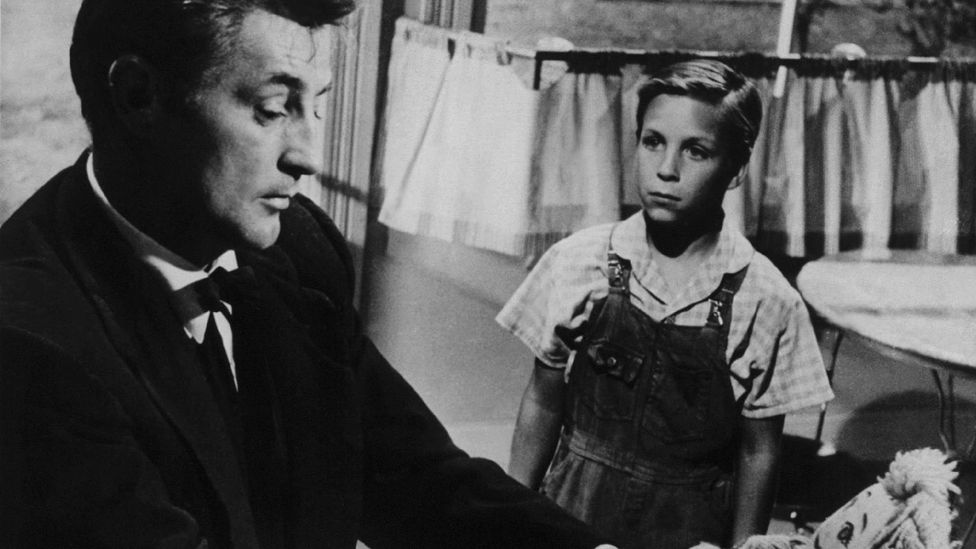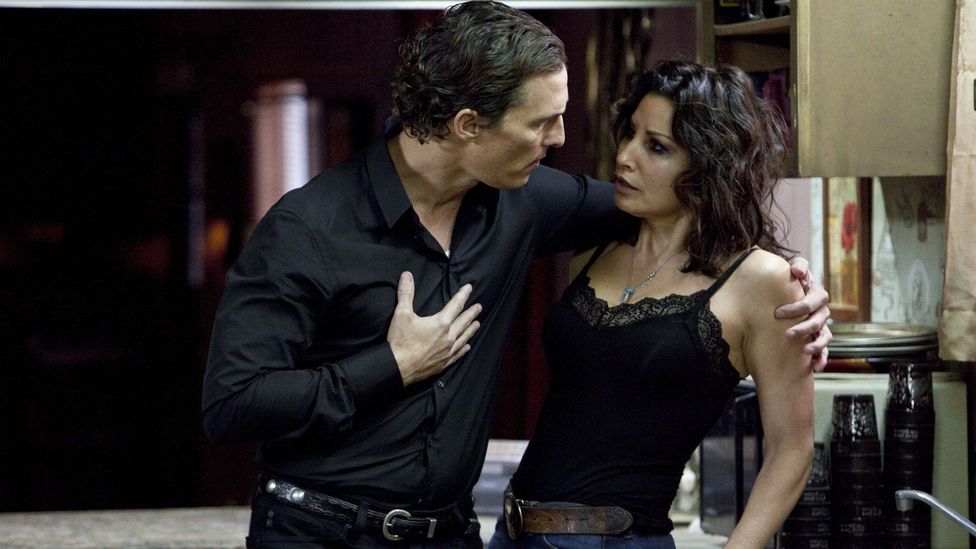With its depraved sex and violence, Netflix’s film The Devil All the Time is the latest take on the Southern Gothic. It’s a genre that is suited to our era, writes Christina Newland.
“Some people were born just so they could be buried,” says a small-town sheriff talking to a young boy in his patrol car. The plain-talking, cornfed folks of Knockemstiff, Ohio circa 1957 are prone to occasional bouts of backwoods philosophising, but are unable to break the cycles of violence and poverty that surround them. This is the grimy world of The Devil All the Time, the fourth feature film from director Antonio Campos, whose hard-as-nails, gun-toting characters come originally from the provocative Southern Gothic novel by Donald Ray Pollock.
Warning: This article contains strong language that might cause offence.
More like this:
– Nomadland review: a film overflowing with humanity
— What makes a great screen rebel?
– The ‘lost’ teen classic finally getting recognition
The story begins with the return from the South Pacific of a young veteran, played by a gaunt Bill Skarsgard, whose hardship turns him toward religious mania. His young son Arvin (Tom Holland) is the progeny of an unhappy lineage, orphaned young, and he is thrown into his grandmother’s house with another young waif, Leonora (Shannon Murphy) whose upbringing is hardly any better. Murder and violence are as common in this town as chicken liver. Death haunts the steps of its characters, young and old, as the narrative moves through Arvin’s story and into overlapping stories of the denizens of the town.

One of The Devil All the Time’s chief focuses is Arvin (Tom Holland), a young man from an unhappy lineage and with a propensity for vengeance (Credit: Netflix)
Knockemstiff and the surrounding environs are peopled by delusional religious fanatics, twisted preachers, corrupt lawmen, and truckstop sex killers. Getting out of this film alive is what you might call a challenge. It features strong performances from a bevy of actors, most memorably Robert Pattinson as a paedophilic evangelical priest. Tom Holland, too, stands out, finding within his familiar boyish innocence the ability to emit a blank-eyed propensity for vengeance. The Devil All the Time is an uncompromising, nasty ensemble piece. Curiously, though, the tone of Campos’s film is sedate, even while the content is incredibly lurid.
This distinguishes the film from many recent cinematic entries of a similar vein; others, like Lee Daniels’ The Paperboy (2012) and William Friedkin’s grease-smeared Killer Joe (2011) lean into a more knowingly absurd, borderline-camp tone. Not so for The Devil All the Time, which encases its grotesquerie in a certain self-seriousness. The author himself, Donald Ray Pollock, provides the twangy, omniscient voiceover in the movie, sometimes overstating what we can already see onscreen, but also giving a chillingly matter-of-fact account of events. This makes the film fit well into the more literary pedigree of Southern Gothic, which began as a subgenre of early 20th-Century US literature. In fact, when the term was coined in the 1930s by a literary critic to describe a new crop of authors, the writing was often so grotesque that ‘Southern Gothic’ wasn’t seen as a positive term.
Horror rooted in reality
It was a style which saw authors like William Faulkner and Flannery O’Connor borrow tropes from the Gothic horror tradition of imperilled women, dysfunctional family dynamics, and domesticity turned deranged. They would then translate these on to their own upbringings, in order to deal with the festering wounds of the Deep South and its bloody legacy of chattel slavery. Although The Devil All the Time is not, strictly speaking, set in the Deep South – existing as it is on the border between Ohio and West Virginia – its vernacular is all Southern Gothic in tone, and its crisscrossing of the state line sees it dip from Union to Confederate territory in terms of each state’s history.
The cinematic versions of the Southern Gothic have also confronted the hypocrisy of white Southern society. From John Huston’s weird, wild Wise Blood (1976) to the undersung Paris Trout (1991), filmmakers have looked with horror at how seemingly devout Christianity has been untroubled by the violence it visited upon the black community.

1955’s The Night of the Hunter, starring Robert Mitchum as a very bad preacher, is a classic of the Southern Gothic genre (Credit: Alamy)
Often, these depictions have focused on figures of white institutional authority – especially in the law and the church – shown to be capable of unspeakable evil. Think of genre classic The Night of the Hunter (1955), where a bad preacher orphans two young children in an attempt to steal their family savings, and, more recently, Killer Joe (2011), where an equally bad policeman blackmails a family to sell their daughter into sex slavery.
The twisted combination of sex and violence that plays out on screen and in books in depictions of the American South is the region’s grim legacy from the antebellum years, wherein the rape of slaves was not only commonplace but in cases where children were produced, protected by law. The morally and sexually degraded Southern household was so often a mixture of secrecy, rape, and hypocrisy that the thematic mixing of sex and violence in the Southern Gothic genre can’t help but feel pointed. In The Night of the Hunter, Robert Mitchum’s charismatic and terrifying preacher cannot consummate his marriages so he turns to murdering widows; in Killer Joe, a victim of domestic violence is forced to fellate a chicken wing for a man’s satisfaction.
In The Devil All the Time, this depravity is also on show. The Mitchum-esque role that Pattinson plays sees him as an even more literal predator where children are concerned, and the killer couple Carl and Sandy (Jason Clarke and Riley Keough) use sex to bait and capture their young male victims, making for a mixture of perverse sexuality. Religion, too, seems to be a sort of disease in the film, both passed on in the blood of Arvin and Leonora and so all-enveloping, it is as if it has been transmitted through the very air of the small town. It can be used as a shield to deflect from evil-doing and a cudgel to beat down others; and even among the more decent of Knockemstiff’s people, their faith is motivated by the idea of a cruel and vengeful God who demands terrible sacrifices of his followers – from the literal family pet to ritualistic murder.
The Devil All the Time is evocative in its sparse, brutal way, and its feel for the setting is striking. You can practically smell the moonshine and the blood; the fried poultry and fresh dirt. But it is also familiar; maybe even derivative. It’s hard to believe that it’s saying anything fresh about cycles of poverty or the regional – and national – ghosts of the Civil War. In a way, Campos’s film is something like its own inhabitants: too trapped by its origins, too stymied by the past. Its sledgehammer stylings and hinterland executions make for a harrowing entry into the Southern Gothic genre, leaning into the godless religiosity at the heart of this rotten worldview. But it’s uncertain as to whether it’s doing anything but repeating the pearl of wisdom we hear Arvin learn from his father: “There’s a lot of no good sonsabitches out there.”

William Friedkin’s 2011 film Killer Joe is a piece of Southern Gothic with a more knowingly absurd, borderline camp tone (Credit: Alamy)
The borderline nihilism of the Southern Gothic feels suited to our era, in some respects. With its sense of haunted rural America, and its awareness of the tainted history of white supremacy, it’s a genre that has a lot to be said for it as a critical tool, destroying any ‘moonlight and magnolias’ romanticism of films like Gone with the Wind. In the hands of less capable artists, it can simply demonise the regional poor; in the hands of the masters of the genre, it can both humanise the characters within, and nonetheless feel damning.
The Devil All the Time is available now on Netflix.
Love film and TV? Join BBC Culture Film and TV Club on Facebook, a community for cinephiles all over the world.
If you would like to comment on this story or anything else you have seen on BBC Culture, head over to our Facebook page or message us on Twitter.
And if you liked this story, sign up for the weekly bbc.com features newsletter, called The Essential List. A handpicked selection of stories from BBC Future, Culture, Worklife and Travel, delivered to your inbox every Friday.


